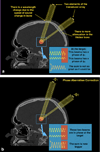Transcranial MRI-Guided Focused Ultrasound: A Review of the Technologic and Neurologic Applications
- PMID: 26102394
- PMCID: PMC4687492
- DOI: 10.2214/AJR.14.13632
Transcranial MRI-Guided Focused Ultrasound: A Review of the Technologic and Neurologic Applications
Abstract
Objective: This article reviews the physical principles of MRI-guided focused ultra-sound and discusses current and potential applications of this exciting technology.
Conclusion: MRI-guided focused ultrasound is a new minimally invasive method of targeted tissue thermal ablation that may be of use to treat central neuropathic pain, essential tremor, Parkinson tremor, and brain tumors. The system has also been used to temporarily disrupt the blood-brain barrier to allow targeted drug delivery to brain tumors.
Keywords: MRI-guided focused ultrasound; brain; brain tumors; movement disorders; neuropathic pain; stroke.
Figures








References
-
- Trumm CG, Stahl R, Clevert D-A, Herzog P, Mindjuk I, Kornprobst S, et al. Magnetic resonance imaging-guided focused ultrasound treatment of symptomatic uterine fibroids: impact of technology advancement on ablation volumes in 115 patients. Invest Radiol. 2013 Jun;48(6):359–365. - PubMed
-
- Napoli A, Anzidei M, De Nunzio C, Cartocci G, Panebianco V, De Dominicis C, et al. Real-time Magnetic Resonance–guided High-intensity Focused Ultrasound Focal Therapy for Localised Prostate Cancer: Preliminary Experience. European Urology. 2013 Feb;63(2):395–398. - PubMed
Publication types
MeSH terms
Grants and funding
LinkOut - more resources
Full Text Sources
Other Literature Sources
Medical

